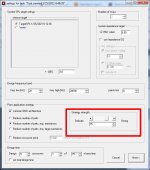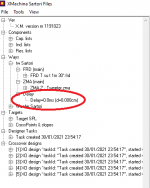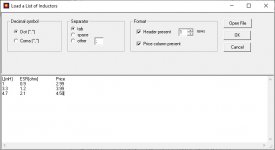After a couple of years of using this software, I think this language change would really be helpful.
I think changing,

"Delicate" to "Complex"
and
"Strong" to "Simple"
would make a lot more sense.
Anyone else find the Delicate and Strong awkward/misleading/confusing?
Otherwise, great program!
David.
I think changing,

"Delicate" to "Complex"
and
"Strong" to "Simple"
would make a lot more sense.
Anyone else find the Delicate and Strong awkward/misleading/confusing?
Otherwise, great program!
David.
Yes, I recently asked the author about that meaning, and he kindly answered. If it is "complex / simple" there would have been no need to ask.
Thanks for all the suggestions. All of them will be taken into consideration when XMachina is back under development (but honestly this may not be very soon).
Thanks for all the suggestions. All of them will be taken into consideration when XMachina is back under development (but honestly this may not be very soon).
That is sad news.
I hope everything is okay.
May I ask why you have stopped working on such an excellent piece of software?
Thank you,
David.
The process with using the actual measurements from each of the different drivers in the cabinet and use them in Xmachina is a very straightforward. Just one thing that is lacking is the distance from listening position to each of the driver (= actual driver offset).
It’s a little bit sad to read that the development of the software is under pause. Wishing for that to change. And wish for some offset management to be implemented. ��
It’s a little bit sad to read that the development of the software is under pause. Wishing for that to change. And wish for some offset management to be implemented. ��
If You measure the drivers at 1m at the tweeter level (or the driver thas lie at ear level) won't the measurement self contain the data you ask for?
I’ll need to measure them separately, and there are some different ways of doing this. As I have the exact different listening angles for both the tweeter and the midbass to the ear I could put the mic at exactly that angle for each of the measures. The tweeter at appr 1,29 degrees up and the midbass 4,26 degrees up at exactly 1 m each. That might do it. But that is because I have designed the cabinet so with a listening position of the ear at 1000 mm above floor there is no distance at a between the position of the different driver diaphragms to the ear. But with the ear or listening length to the speaker that will change. And if it’s a difference between the length from the different drivers to the ear it would be great if the feature asked for could to be there in the software. I think 🤔
I guess You allready know the sofware can apply "delay" expresed in ms or distance to any of the measured files, and it is not what You are asking for?
Mosquito, no actually I don´t. Looked around and couldn´t find it. How does it work and where do I find it? Please enlighten me.
Measuring the actual spl responce seem to be the way. But I also then need to measure the impedance throughout the register for each driver, which is another story..... 🙂
Measuring the actual spl responce seem to be the way. But I also then need to measure the impedance throughout the register for each driver, which is another story..... 🙂
@Mosquito. Thanks. Might be the one. Will look into it.
As the process will be to build the cabinet and then measures spl and imp, the process will be rather straight forward going from there.
The process as I see it:
01) Decide on design. Done, and can be seen here. MLTL with coupling chamber for SS D8531G00 and SS D2608/Elsinore WG.
02) Read and ask for input regarding measuring mic and software for spl.
03) Read and ask for input regarding measuring how to measure imp and required software.
04) Decide on mic and software for spl measuring.
05) Decide on way and software for measuring imp (if not the same as for spl).
06) Build the cabinet w no paint etc.
07) Mount the drivers in the cabinet.
08) Insert the proposed amount of polyester stuffing.
09) Measure spl for midbass
10) Repeat 08-09 with different levels of stuffing until "best performance"
11) Replace the polyester stuffing in the coupling chamber with egg shell rug.
12) Measure and adjust.
13) Repeat 12 until "best performance".
14) Select the best result from bullet 10 and 13.
15) Measure midbass impedance.
16) Measure tweeter spl (maybe also play with damp rug etc on front baffle)
17) Measure tweeter imp.
18) Load measuring result into Xmachina.
19) Set up a reasonable target spl in Xmachina based on measured drivers.
20) Create a few different xo designs (LP6-12 db, HP6-12db, xopt 2,0-2,4khz, xo dept +4 to -6 db etc).
21) Select "best option" based outcome and build simplicity
22) Load into Xsim and/or Vituixcad to see explore for eventual more adjustments.
23) Build XO, connect and measure the result from speakers
24) Listen in "open garage" (closest to 1, 2 and 4 piradians) and in listening room.
25) Adjust spl target based on measuring and listening results.
26) Run Xmachina again.
27) Repeat 20 to 26 until satified.
28) Remove drivers.
30) Finish the cabinet.
31) Mount the drivers.
32) Build the final XO onto the cabinet.
33) Move the speakers into listeing room and plug in.
34) Turn off telephone and wave wife and and dog goodbye for their trip somewhere
35) Enjoy!
Something like that. Being at bullet 02 going for 03 to 05 it´s not much left ;-)
As the process will be to build the cabinet and then measures spl and imp, the process will be rather straight forward going from there.
The process as I see it:
01) Decide on design. Done, and can be seen here. MLTL with coupling chamber for SS D8531G00 and SS D2608/Elsinore WG.
02) Read and ask for input regarding measuring mic and software for spl.
03) Read and ask for input regarding measuring how to measure imp and required software.
04) Decide on mic and software for spl measuring.
05) Decide on way and software for measuring imp (if not the same as for spl).
06) Build the cabinet w no paint etc.
07) Mount the drivers in the cabinet.
08) Insert the proposed amount of polyester stuffing.
09) Measure spl for midbass
10) Repeat 08-09 with different levels of stuffing until "best performance"
11) Replace the polyester stuffing in the coupling chamber with egg shell rug.
12) Measure and adjust.
13) Repeat 12 until "best performance".
14) Select the best result from bullet 10 and 13.
15) Measure midbass impedance.
16) Measure tweeter spl (maybe also play with damp rug etc on front baffle)
17) Measure tweeter imp.
18) Load measuring result into Xmachina.
19) Set up a reasonable target spl in Xmachina based on measured drivers.
20) Create a few different xo designs (LP6-12 db, HP6-12db, xopt 2,0-2,4khz, xo dept +4 to -6 db etc).
21) Select "best option" based outcome and build simplicity
22) Load into Xsim and/or Vituixcad to see explore for eventual more adjustments.
23) Build XO, connect and measure the result from speakers
24) Listen in "open garage" (closest to 1, 2 and 4 piradians) and in listening room.
25) Adjust spl target based on measuring and listening results.
26) Run Xmachina again.
27) Repeat 20 to 26 until satified.
28) Remove drivers.
30) Finish the cabinet.
31) Mount the drivers.
32) Build the final XO onto the cabinet.
33) Move the speakers into listeing room and plug in.
34) Turn off telephone and wave wife and and dog goodbye for their trip somewhere
35) Enjoy!
Something like that. Being at bullet 02 going for 03 to 05 it´s not much left ;-)
Last edited:
That's very useful. Thanks!
I will anyway go ahead and try to compile a list of what's available to me here in the US. Will share the list once I am done with it. Hopefully that will be useful for others who plan to use XMachina.
How are things going with this topic?
On Jantzen audios homepage there is an export for their (air) coils which is interesting. The problem is that they make thousands of different coils, which most of them are not sold anywhere I know of. So they have sorry to say no "Mostly sold" list. And trying to import it to Xmachina I got a thousand error messages telling me that the value wasn´t that useful in XO designs 🙂. So that seem not to be a good idea to import the whoel Jantzen audio air coil production list.
@Mosquito. Thanks. Might be the one. Will look into it.
34) Turn off telephone and wave wife and and dog goodbye for their trip somewhere
35) Enjoy!
Something like that. Being at bullet 02 going for 03 to 05 it´s not much left ;-)[/QUOTE
absolutely!😀
Anyone with experience of how to get the measures from the tweeter and midbass drivers and the port into the software in a good way? I am thinking of far field measures in several directions (0, 10, 20 etc Hor + Ver) and near field for the mid and near field from the port. As well as far field in several directions (0, 10, 20, 30 etc) for the tweeter.
Hi there, can someone please explain what the "Reverse phase dip req." is for when setting left and right slope targets and what it's purpose is. I've been playing around getting some results but need to know what this actually is for. I've watched the YouTube example but it has no explanation.
A quick filter synthesis for illustration. The blue curve is a system response for a filter designed with 5dB setting in "reverse phase dip required". The green curve is for 25dB. XMachina added 2 extra components to achieve this.
Use it or not, there is an option for such a target.
You can also find description for the "reverse phase dip required" parameter on page 24 in the pdf.
Use it or not, there is an option for such a target.
You can also find description for the "reverse phase dip required" parameter on page 24 in the pdf.
Attachments
And trying to import it to Xmachina I got a thousand error messages telling me that the value wasn´t that useful in XO designs 🙂.
Check the units. Consider a component table like this :
The intention of table creator is clear however the inductance values will be interpreted as 1H, 3.3H, 4.7H (i.e. 1000mH, 3300mH, 4700mH respectively). You probably won't be able to design any sensible crossover with components like these, hence the warning.
The solution is to change "1, 3.3, 4.7" to "1m, 3.3m, 4.7m" or "1mH, 3.3mH, 4.7mH"or 1E-03, 3.3E-03, 4.7E-03" as you prefer.
Attachments
- Home
- Design & Build
- Software Tools
- Automatic crossover designing with XMachina



